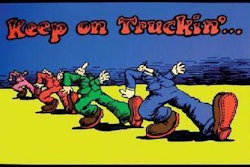Fleet Safety Services consultant Jeff Davis got a pretty resounding series of groans from his audience when he introduced a session last week at the National Association of Small Trucking Companies’ annual meeting in Nashville, Tenn. His subject: the implementation, utilization and subsequent enforcement issues surrounding electronic logging devices.
Davis puts the impending electronic log mandate among “the biggest changes we’ve had in safety and compliance and in the industry generally in the last 50 years.” Ripple effects, necessarily, will be felt.
 Jeff Davis
Jeff DavisBut not to be discouraged, however, “we’ll get through this e-log implementation,” he said, and “there’s a pot of gold out there for all us who can make it through.”
For the smallest of fleets, the majority of whom have yet to implement any e-logging system whatsoever, according to previously published Overdrive research, challenges to implementation include the necessity of back-office staff to better assist on-highway drivers with freight scheduling to meet ever tighter delivery windows around rigidly defined hours-of-service limits. Renegotiation of freight contracts with shippers to include mandatory detention pay for drivers, too, is often a tactic that comes as a natural outgrowth of e-log implementation, Davis says, putting leverage on a customer to improve loading/unloading efficiency.
As it is today, too often shippers are turning truck drivers into “truck waiters,” Davis says. Reducing detention time “is one of the great keys to electronic logs.”
Many of Davis’s clients initial see a 12-15 percent reduced rate of productivity with implementation, with a boost in costs.
“So I should get ready to sell my truck,” said an owner-operator in the audience at the event who counted himself among the 70 percent of independents who, according to past Overdrive research, said that they’d leave the industry before they’d run with an e-log.
Davis gave back a resounding no — “You should get ready to make money.”
Carriers of all sizes are getting aggressive in educating shippers about what the change will result in, Davis added. After implementation of the 14-hour rule, the hours of service already are “no longer a stopwatch” that can be flexed by that heretofore most elastic link in the supply chain — the driver. An hourglass metaphor is more applicable, and with e-logs, Davis takes it a step further. Drivers have dealt with the inflexibility of the 14-hour glass by turning over another one from time to time in today’s world. “With e-logs, there’s no other hourglass to turn over.” Davis said.
He cited the J.B. Hunt “660 Minutes” study, geared toward the company’s shipper customers, that found on average in a study of 3,000 drivers, drive time utilized was merely 6.5 hours for every possible 10. “We have to do better than this if we’re going to supply the freight to America,” Davis said. “We’re on a collision course to really getting into it with our shippers.”
His suggestion to the small carriers in attendance was to get their feet wet in the area of e-logs today. “My suggestion is to embrace it today. You don’t have to convert your whole fleet. Get a couple units, start learning it. Take a bite of it and start working in that direction.”










